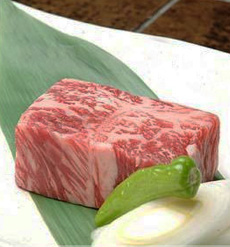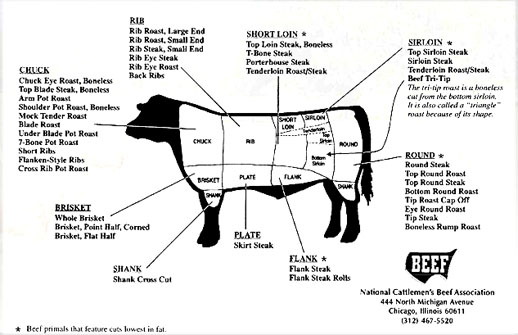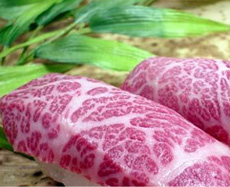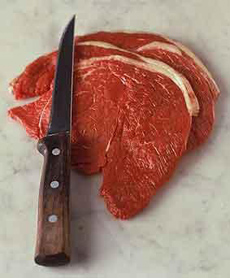Beef Glossary: A Glossary Of The Different Beef Types & Beef Cuts DiagramPage 4: Types Of Beef Terms & Definitions J To N This is Page 4 of an 8-page article. Click on the red links below to visit other pages. This glossary is protected by copyright and cannot be reproduced in whole or part. You are welcome to link to it.
|
 The fat marbling in kobe beef is so extensive, it seems to equal the amount of beef itself. Photo courtesy TheWagyu.com. |
|
|
If you’re looking for the definition of a particular cut of beef, you’ve come to the right place. Here’s the lingo butchers and other industry professionals use as they cut beef. (If you’d like to suggest additional words, click here.) On this page of the glossary, you’ll find terms such as aged beef, beef bacon, beef cheeks, beef jerky, beef stew meat, Black Angus beef and an answer to the question, What is beef? When looking up beef cuts, it’s helpful to refer to the beef cut diagram, courtesy of the National Cattleman’s Beef Association. If you enjoy this Beef Glossary, we have a food glossary for almost every category of food—including a Lamb Glossary and a Pork Glossary. 
Download your own beef cuts chart (pdf).
|
||
| JERKY Strips of meat are slowly cooked over wood chips, which smokes and preserves the meat. Jerky has been made since ancient times for exactly that reason: It traveled well, and the prepared meat kept for a long time. Well-made jerky is rich and smoky. The word "jerky" itself comes from the Quechua (Inca) word charqui, dried meat. While some people think of jerky as dry and chewy, gourmet products are moist and delicious. You can read reviews of some of our favorite gourmet jerky. KANSAS CITY STRIP STEAK |
 Pecan-smoked beef, applewood-smoked beef and turkey jerky. Photo by Michael Steele | THE NIBBLE. Read the review. |
|
| KOBE BEEF
Kobe is a brand name of Wagyu, named after the Kobe prefecture in Japan, where it is raised. A very high grade of beef from black-haired Wagyu cattle, during the 2nd century C.E., Wagyu, was already a legendary breed when it was brought from its home on the Asian mainland to Japan. The breed was refined in the Kobe region of Japan over two thousand years and has become famous for its intense flavor and extreme tenderness. In Japan, Wagyu cattle are often crossed with other breeds (for example, some American Wagyu brands are a cross of Wagyu and the American Black Angus). In the beginning, the marketing led people to belief that these cattle were pampered, massaged and brushed with saké and fed beer-and-saké mash. That may have been true with the original small herd, but large production makes that kind of treatment unfeasible. Still, this is quality stock, treated well, and it produces very tender yet full-flavored beef. Because of import restrictions, branded Kobe is not currently available in the U.S., due to testing issues for BSE* required by the USDA and the ability to consume most of what is produced at home. However, other Wagyu beef is now being imported to America, inspected as BSE-free before it leaves Japan and again by the USDA. Also, U.S. ranchers are applying the same breeding practices and producing a domestic Wagyu. For a comparison of prices, at Lobel’s Prime Meats in New York City, a 16-ounce boneless American Wagyu steak sells for $68.98, a prime dry-aged boneless New York strip steak is $46.98 (as of April 2007). *BSE, bovine spongiform encephalopathy, commonly known as mad-cow disease. |
 Sirloin slices, showing the extensive fat marbling that defines kobe beef. Photo courtesy TheWagyu.com. |
|
| LOIN CUTS Cuts of beef from the loin are among the most tender and the most expensive, but not necessarily the most flavorful. The tenderloin is the most tender of all steaks. It is a boneless cut that comes from the long muscle that runs along both sides of the backbone. It lies beneath the strip loin (strip steak). It can be purchased as a whole or partial tenderloin, but is usually cut into small medallions or filet mignons. Since filet mignons contain very little fat or marbling, they are usually wrapped in bacon or cooked with some form of fat to add flavor. Chateaubriand is a large section cut from the thickest part of the tenderloin. It is meant to serve two people. The T-bone is a steak with a T-shaped bone: on one side is an oval tenderloin, on the other side is a top loin, or strip steak. Some call it the “king of steaks” because it is two steaks in one, the best of both of the cuts in one steak: the tenderness of the tenderloin and the flavor of the strip steak. The porterhouse is a larger T-bone, containing more of the tenderloin and the sirloin strip. |
||
| LONDON BROIL London broil is a cooking method, not a cut of meat. London broil is made from tough cuts such as flank steak. It needs to be well-seasoned and cooked to medium rare; then sliced very thin against the grain. |
||
| MARBLING Marbling is the intramuscular fat, the flecks of fat within the lean. The amount of marbling relates to quality grading: Greater amounts of marbling result in a higher quality grade. Marbling enhances palatability by increasing juiciness and flavor. |
 Beef from Wagyu cattle, the generic breed of Kobe, has the highest degree of marbling. Photo courtesy TheWagyu.com. |
|
| MEAT INSPECTION Required by federal law to provide assurance of wholesomeness of meat to be sold. Meat inspection assures that meat is wholesome, has been handled in a sanitary manner and is properly labeled. Inspection of meat products is conducted by the USDA/FSIS as a public service, and is paid from tax funds.
|
||
| MIDDLE MEATS Cuts from the rib and loin section of the beef animal. |
||
| MINUTE STEAK or CUBE STEAK A thin cut of steak that can be cooked “in a minute,” although five minutes might be more accurate. It is a popular cut with people who have the desire for, but not the time to cook, a thick steak. It is also very quick to thaw. A minute steak can be cut from the round, the sirloin, or any boneless cut of beef. To ensure tenderness, the meat is run through a tenderizing machine by the butcher or pounding with a kitchen mallet (it is called a cube steak because of the cube-shaped score marks that are produced by the tenderizing machine or the mallet). It is also an excellent cut for steak sandwiches. For top-of-the-line minute steak, ask your butcher to cut slices from the shell roast, the cut used for strip steaks. |
 A delicious minute steak from WomackFarms.com. |
|
| MOIST HEAT COOKING Moist-heat cooking uses liquid to cook the meat in a covered pot in the oven, on the range or in a slow-cooker. It is used for tougher cuts such as chuck, round, tip, fore shank, plate and flank. ORGANIC & NATURAL MEATS: |
||
| NATURAL BEEF With natural beef, the animals are allowed to grow naturally, i.e., without growth hormones. They are fed quality diets, generally a vegetarian corn-based diet for 300+ days. This natural feeding process takes an additional 45 days for the animals to reach market, which is why natural beef is both more expensive and higher quality. While there are many fine natural ranchers, there is no industry regulation of the term “natural.” Thus, any company can call its product natural, and, unlike with organic products, there is no inspector to verify whether it is or not. See also organic beef. |
||
| NEW YORK CUT Also known as the Philadelphia cut, the New York system of cutting beef is the major system used in the U.S. The other is the Boston cut. The first point of difference is when a side of beef is cut across at right angles to the backbone, into the hind quarters and the fore quarters. In the New York system, all ribs are left on the fore quarter; in the Boston system, three ribs are left on the hind quarter. Thus, the first cut of the fore quarter in the New York system (a prime rib roast) is the same piece of meat as the first cut on the hind quarter in Boston. There are many other points of confusion. The U.S. Department of Agriculture uses the New York system; the Boston system is used only in New England. |
||
| NEW YORK STRIP STEAK or NEW YORK STEAK or BONELESS STRIP STEAK or KANSAS CITY STRIP or SHELL STEAK or TOP LOIN The strip steak is a firm-textured, well-marbled cut, tender, juicy and and flavorful, that is a favorite among steak-eaters (it’s the second most popular cut). It comes from the most tender section of beef, the short loin—it is the boneless top loin muscle, a porterhouse minus the tenderloin and the bone. However, some people leave the bone in on a strip steak, believing that it optimizes the flavor. The strip steak is also known as the strip loin, Delmonico, boneless loin, boneless club steak, or sirloin strip (which is confusing because it’s not really part of the sirloin). Ideally, the steak should be cut 1-1/2 to 2 inches thick. Connoisseurs say that keeping the bone in optimizes the flavor.
|
 New York Strip Steaks from Rocky Mountain Gourmet Steaks. |
|
Last Updated Apr 2018
© Copyright 2005-2024 Lifestyle Direct, Inc. All rights reserved. All images are copyrighted to their respective owners.